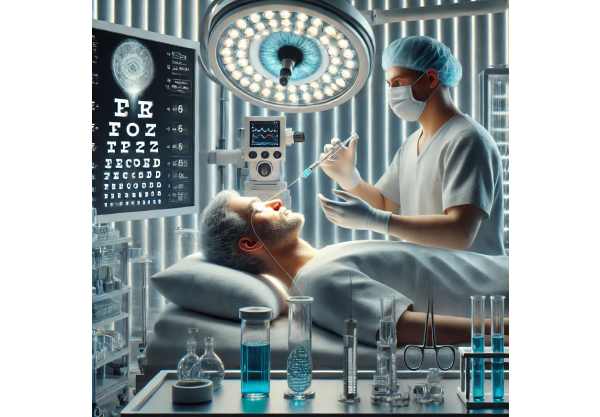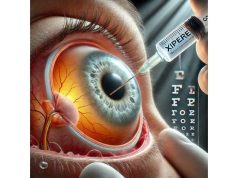
What causes Leber’s Hereditary Optic Neuropathy?
LHON is a rare inherited mitochondrial disorder that causes sudden and severe vision loss. It primarily affects young adults, usually between the ages of 15 and 35, but it can happen at any age. Mutations in mitochondrial DNA (mtDNA) pass down maternally, causing the condition. The most common LHON mutations occur in the ND1, ND4, and ND6 genes, which are required for the mitochondrial respiratory chain to function normally and produce cellular energy.
LHON is distinguished by acute or subacute loss of central vision in one eye, followed by the other in weeks to months. The degeneration of retinal ganglion cells and their axons, which primarily affects the papillomacular bundle, causes this bilateral vision loss. As a result, patients develop central scotomas, or blind spots, which severely impair detailed vision while preserving peripheral vision. A combination of clinical findings, family history, and genetic testing to identify specific mtDNA mutations confirms the diagnosis of LHON.
Understanding the genetic and pathophysiological mechanisms that drive LHON is critical for developing targeted treatments. Historically, LHON has been managed primarily through supportive care and lifestyle modifications. However, advances in genetic research and therapeutic technologies have created new opportunities for more effective interventions. This article discusses both traditional and cutting-edge approaches to treating and managing Leber’s Hereditary Optic Neuropathy.
Traditional Approaches to Treating Leber’s Hereditary Optic Neuropathy
As there is no definitive cure for Leber’s Hereditary Optic Neuropathy, treatment and management have traditionally focused on supportive care and slowing the progression of vision loss. Traditional approaches aimed to provide symptomatic relief and improve the quality of life for patients suffering from this condition.
Supportive Care and Visual Aids
Supportive care has long been a cornerstone of LHON management, with the goal of assisting patients in adjusting to vision loss and maintaining their independence. Key strategies include:
- Low Vision Aids: Magnifiers, telescopic lenses, and electronic visual aids can help make the best use of residual vision. These tools are tailored to patients’ individual needs, allowing them to perform daily tasks more independently.
- Assistive Technology: Modern technology has resulted in the development of a variety of assistive devices, including screen readers, braille displays, and voice-activated software. Individuals with LHON can benefit significantly from these tools, increasing their accessibility and independence.
- Occupational Therapy: Occupational therapists help patients develop strategies and techniques for managing daily tasks and improving their quality of life. This could include training in the use of assistive devices and modifying living spaces to improve safety and accessibility.
Lifestyle Modifications
Lifestyle changes are an important part of managing LHON, especially in lowering the risk of triggering or exacerbating vision loss. Recommendations usually include:
- Avoidance of Mitochondrial Toxins: Tobacco smoke and alcohol are two substances that can exacerbate mitochondrial dysfunction and should be avoided. To reduce the risk of further vision loss, patients should quit smoking and limit their alcohol consumption.
- Nutritional Support: A healthy diet high in antioxidants and vitamins may improve mitochondrial function. Although evidence for their effectiveness is limited, some clinicians recommend supplements such as coenzyme Q10, vitamin B12, and other nutrients thought to benefit mitochondrial health.
Pharmaceutical Interventions
Pharmacological treatments for LHON are limited and primarily experimental. Some medications that have been explored are:
- Idebenone: Idebenone, a synthetic analogue of coenzyme Q10, has shown promise in clinical trials. It is thought to improve mitochondrial function and lower oxidative stress. While not universally effective, idebenone has been approved in some countries for the treatment of LHON and may benefit some patients, especially if given early in the disease’s course.
- Other Antioxidants: Many antioxidants, including alpha-lipoic acid and vitamin E, have been studied for their ability to reduce oxidative stress and promote mitochondrial health. However, strong clinical evidence supporting their efficacy in LHON is lacking.
Genetic Counseling
Genetic counseling is an important part of managing LHON. Families affected by LHON receive information about the disease’s genetic nature, inheritance patterns, and the likelihood of occurrence in future offspring. Genetic counseling can also help people decide whether to get genetic testing or participate in clinical trials.
Limitations of Traditional Approaches
While traditional approaches have been beneficial to individuals with LHON, they are primarily palliative and do not address the underlying genetic causes of the condition. As a result, there is little hope for significant vision improvement or restoration. The development of novel treatments, particularly those that target the genetic basis of LHON, has transformed the landscape of potential interventions.
Cutting-Edge Innovations in Leber’s Hereditary Optic Neuropathy Treatment
Recent advancements in genetic research, molecular biology, and ophthalmic technologies have resulted in ground-breaking advances in the treatment of Leber’s Hereditary Optic Neuropathy. These cutting-edge therapies aim to address the underlying genetic mutations and restore retinal function, providing new hope to patients suffering from this difficult condition.
Genetic Therapy
Gene therapy has emerged as one of the most promising treatments for LHON, particularly for cases caused by specific genetic mutations. The idea behind gene therapy is to insert a functional copy of the defective gene into the patient’s retinal cells, restoring normal protein function and improving vision.
- LUMEVOQ (Lenadogene Nolparvovec): GenSight Biologics developed LUMEVOQ, a gene therapy product, to treat LHON associated with the ND4 mutation. The treatment consists of a single injection of a viral vector carrying the functional ND4 gene directly into the eye’s vitreous. Clinical trials have shown significant improvements in visual acuity, with some patients achieving significant vision restoration.
- Other Gene Therapy Trials: Current clinical trials are investigating gene therapy for LHON caused by mutations in other genes, such as ND1 and ND6. These studies aim to broaden the applicability of gene therapy to a wider range of LHON patients, with the potential for widespread vision restoration.
Mitochondrial Replacement Therapy
Mitochondrial replacement therapy (MRT) is a novel approach that replaces damaged mitochondria with healthy ones from a donor. Although still in the experimental stage, MRT has the potential to treat mitochondrial disorders such as LHON.
- Pronuclear Transfer: Pronuclear transfer is the process of transferring nuclear DNA from a fertilized egg with defective mitochondria to a donor egg with healthy mitochondria before implanting it into the mother. This technique has been successfully used in animal models and early human trials, and it has the potential to prevent the transmission of mitochondrial disorders.
- Spindle Transfer: Spindle transfer is similar to pronuclear transfer, but it involves transferring nuclear DNA from the mother’s egg to a donor egg prior to fertilization. This approach is being studied for its ability to prevent mitochondrial diseases, including LHON, from being passed down to future generations.
Stem Cell Therapy
Stem cell therapy is another promising treatment option for LHON, as it replaces damaged retinal ganglion cells with healthy, functional stem cell-derived cells.
- Retinal progenitor cells (RPCs): RPCs are retinal cells in the early stages of development that can differentiate into a variety of retinal cell types, including ganglion cells. In preclinical studies, transplanting RPCs into the retina demonstrated the potential to regenerate damaged retinal tissue and restore vision. Clinical trials are underway to investigate the use of RPCs in LHON and other retinal degenerative diseases.
- Induced Pluripotent Stem Cells (iPSCs): By reprogramming adult cells into a pluripotent state, iPSCs can differentiate into any cell type, including retinal cells. For LHON, iPSCs derived from the patient’s own cells can be used to generate retinal cells that are free of the genetic defect, lowering the risk of immune rejection and encouraging retinal repair.
Pharmaceutical Advances
New pharmacological treatments for LHON that target the underlying mitochondrial dysfunction are in the works.
- EPI-743: EPI-743 is a novel redox-active molecule that helps to restore mitochondrial function and reduce oxidative stress. Early clinical trials have yielded encouraging results in improving visual outcomes in LHON patients.
- Raxone (idebenone): Although idebenone has been used in traditional treatments, new formulations and dosing strategies are being investigated to improve its efficacy. Research is ongoing to improve its use in conjunction with other therapies for better LHON management.
Neuroprotective Therapies
Neuroprotective therapies seek to preserve and protect the remaining retinal ganglion cells from further degeneration, potentially slowing the progression of LHON and preserving visual function for an extended period of time.
- Neurotrophic Factors: Neurotrophic factors are proteins that promote the survival and function of neurons, including retinal ganglion cells. Treatments that deliver neurotrophic factors, such as brain-derived neurotrophic factor (BDNF), are being studied for their ability to slow retinal degeneration and preserve vision in LHON patients.
- Anti-Apoptotic Agents: Apoptosis, also known as programmed cell death, contributes to the loss of retinal ganglion cells in LHON. Anti-apoptotic agents seek to halt this process and protect retinal cells from degeneration. The search for drugs that can effectively prevent apoptosis and maintain retinal function is ongoing.










